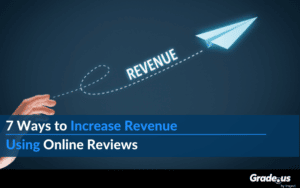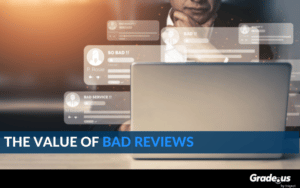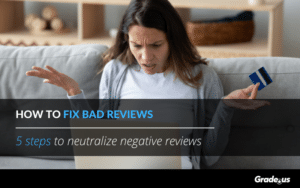Updated 5/23/2022
You’ve done an amazing job.
Your customers are happy, satisfied, and thankful for your help. You’ve wowed your customer. If they’re happy, it stands to reason that you’ll be able to get a positive review… especially if you ask customers the right way.
Many organizations don’t.
Think about your own experience, how many times do you do business with a company each week? How many of those companies make an effort to request a review from you?
Not many if you’re like most.
But why? Requesting a review usually triggers our fears of rejection so many of us choose to take the easy way out. We hope that customers will write a review on their own. Or we send out a half-hearted email but we’re disappointed when the review isn’t what we had hoped for.
What if there was a way to almost guarantee a yes, when you request a customer review?
This sounds crazy, is it possible?
Absolutely. But how?
You make a face-to-face request
Vanessa Bohns of Cornell University and Mahdi Roganizad of Western University showed in their research that face-to-face requests are better than impersonal requests made via email.
How much better?
Face-to-face requests were 34 times more effective than emailed requests.
That’s a dramatic difference.
In their study, they asked participants to request surveys from strangers. One group via email, the other in person. Next, they asked them to predict how many strangers would do what they want.
Here’s an interesting part about their study.
Participants in the email request group believed email was just as effective as a face-to-face request. They were just as confident as participants in face-to-face group.
Why is that?
Vanessa explains: “Participants were highly attuned to their own trustworthiness and the legitimacy of the action they were asking others to take when they sent their emails.”
Which is basically saying “I’m trustworthy so I’ll get what I want.” Which of course is the opposite of what happened.
Strangers saw an untrustworthy email asking them to click on a sketchy link.
They didn’t do it.
Here’s the surprising part about this study.
It doesn’t matter who you ask – family, friends, strangers, it makes no difference. As soon as you decide to go from face-to-face to email, your odds of success decrease dramatically.
The odds are in your favor…
Just not as much, if your requests are delivered via impersonal channels like email or text. When these researchers replicated their results in a second study they found out why.
We’re missing much needed information.
The non-verbal cues we normally share – our body language, gesture clusters, tone of voice, emotional health, etc. – this information was missing. Simply put, impersonal channels like email don’t automatically include the information we needed to evaluate a request.
Okay, so face-to-face requests are more effective.
How do you use that in your organization? You approach customers directly, meeting with them face-to-face.
That wasn’t the real question though, was it?
The real question is, how do you scale this? How do you approach hundreds or thousands of customers with your request for a review? Who on earth has the time to speak to thousands of people, one-on-one?
You do.
Your problem isn’t time, it’s leverage
Most of the time people assume they have to approach customers one-on-one, pounding the pavement – doing what they have to do to get amazing reviews.
The one-on-one approach is tedious.
It’s exhausting, time consuming, and difficult. It’s also unrealistic. It just doesn’t make sense to approach review management that way. So what’s the best way to tackle this problem?
Leverage.
Leverage is a force multiplier, a way to get more done with less. It’s a powerful way to maximize the results you’re able to get, enabling you to attract more positive reviews with less effort.
How’s that possible?
Don’t go to your customers, entice them to come to you.
Approaching customers one-on-one is doable when you’re just starting out, or if you have a small number of customers. Not so much when your customers number in the hundreds or thousands.
So, how do you get them to come to you?
- Give a speech or talk. Share information with customers. They can be new, veteran or all-star customers, doesn’t matter as long as you teach them something new.
- Create regular meetup. Invite your best customers to a prestigious invite-only retreat where you build relationships, thank them for their loyalty, and spoil them a little bit.
- Run a seminar, workshop or event. Create a seminar that’s made for new and existing customers. Blow their minds with the information you provide at your workshop or event, then during the break, invite them out into the hallway where they share their review on camera.
- Attend a convention. Become a keynote speaker or featured presenter at conventions. Get feedback from your customers and prospects alike, identifying objections, fears, risks and their overall experience.
You’re not limited to these ideas.
In fact, there’s another way you can scale your face-to-face review requests.
You can target your best customers first.
Here’s how you do it.
Step #1: Look for behavioral markers
Look for customers who display two or more of the following qualitative traits.
- Relationship: These customers have a strong, healthy, and active relationship with your company. They love your company and they’re willing to demonstrate this with action (e.g., they spend more, purchase more often, ask for more).
- Engagement: These customers are comfortable sharing their feedback (positive or negative); they’re comfortable telling you when you’re doing well and when you’re making a mistake. These customers are quick to call, write, and discuss their point of view with you.
- Admiration: Customers who admire your brand show it. They brag about your company, use your company as a status, or prestige symbol (think Apple, Mercedes, Tesla) and they display an active interest in the company. These customers are typically eager to buy, regardless of the price, because their admiration confers specific benefits to them.
Make a list of the customers who meet at least two of these criteria. This is going to be a subjective assessment based on the details you know about each customer.
If you have a large list of customers this will be a difficult thing to figure out unless you rely on another variable to identify what works best.
Step #2: Look for outcome markers
These are the quantitative traits customers display.
- Repeat sales from specific customers
- Purchase frequency
- Customers who consistently purchase services with a high profit margin
- High quarterly, monthly, or annual spending
- High per customer revenue
- Product/service consumption rates
These quantitative traits are behaviors you can see, details you can measure. That’s important because these outcome markers help you to identify behavioral markers.
You’ll want to use them both.
Step #3: Create a list of your best customers
Using these markers, create a list of customers in your business who meet these criteria. You should be able to get this information from:
- Accounting departments (outcome markers)
- Customer service teams (customers with behavioral and outcome markers)
- Fulfillment teams (addresses that receive the most orders)
- Product research and development (i.e., best selling products and services that produce 80% of your revenue)
- Sales teams (best selling products and services)
These should be your best customers.
Step #4: Craft your review request
You’ll want to customize your review requests for each type of customer. If you’re working with B2C, create something for them. Ecommerce clients, craft a request that speaks directly to them.
This doesn’t have to be complicated. It could be as simple as you saying the following:
Subject: [Name], you are something else, you know that?
Hi [Name],
You are something else.
You purchased our [product] way back in [year] and you’ve been a loyal customer ever since. You’ve helped us improve our services on [##] separate occasions, and you consistently go out of your way to help us.
You’re wonderful.
So what can we do to make you happier? We want to improve and we believe you’re the best person to ask. Would you be willing to answer 6 questions for us?
[Signature]
If they say yes, you schedule a face-to-face chat via zoom or in-person (depending on the size of your business). For maximum effectiveness, you’ll want to include your LinkedIn profile in your signature so they can put a face to the name.
Here’s the thing about this template.
It has to be genuine.
Don’t feed your customers a line about how important they are to your business if it isn’t true. They’ll see it and it’ll ruin your relationship with your customers.
This has to be authentic.
This is a must.
If you send customers this pitch you may very well get a ton of feedback. You’ll want to get their permission to record the video ahead of time. If they say No, no worries! Others will be open to you recording. Just continue on and finish the interview.
What if they’re open?
Well that’s really good news. That means you’ll be able to:
- Use their video testimonial on your site
- Transcribe their feedback for your site
- Send them the transcript, asking if they’d be willing to post their words on a review site (e.g., Yelp, Google Reviews, TripAdvisor, etc.)
- Use this review in your marketing materials
- Improve your products and services with your customer’s feedback
What if they say No?
No worries, mark these customers as non-responders but leave them in your list. Then continue on without them. Anytime you receive a negative review you have the opening you need to contact these non-responders, like this:
Signature: [Name], she just called us a [quote]… Help!
[Name],
We need your help!
A reviewer by the name of [reviewer name] just posted this negative review, trashing us on Yelp. Would you be willing to share your experience at [business]?
We could really use your help!
My name is [Your Name], I’m the [title] at [company]. I thought I’d reach out to you personally. We have a longstanding relationship with you and I feel you know us best.
Thanks either way!
[Signature]
P.S. No worries if you’re busy, we understand and we appreciate everything you’ve done for us.
Can you see what’s happening?
You’ve reached out to customers who are promoters, they love your company and they’re willing and able to buy. These are the people who are most willing to champion your business. They’re part of your tribe.
Reach out to them first.
The sky’s the limit. The focus is really about getting your customers to come to you. They can be new or established. Your best or most infrequent customers.
Just bring them together.
There’s no way to bring them together
It sounds delusional, I get it.
At first glance, it seems like an incredible amount of work for a payoff that may not work out. How do you create leverage needed to make the face-to-face ask effective if you can’t get your customers together?
You spring for the next best thing.
You use video to make your face-to-face request. How? With video ads. Here’s how it would work.
- Tag recent customers. Running an ecommerce store? Sent a proposal and closed the sale with a new client? Tag them so you can reach out the them later.
- Segment your customers. Sort your customers into the buckets that matter to you. This could be new vs. loyal customers, $ vs. $$ customers, or anything in-between.
- Craft your message. Create a video where you reach out to customers, telling them why their feedback/review matters and how they can help.
- Deliver your message. Use remarketing to deliver the right message to each of your customer segments. Send customers to a landing page where you make their request official.
- Combine with email. Include a ‘somewhat’ personal video in the emails with your review request for best results.
As far as face-to-face requests go, it’s the next best thing. Want to maximize your results? Follow these steps.
Personalize tastefully, wherever and whenever you can.
Don’t ruin the relationship by spamming. Remarket with care.
Focus on one message, your request for a review. Don’t combine it with any other message.
Give customers just enough time to evaluate your product or service. No more, no less.
Use a familiar face for your face-to-face ask.
Then structure your face-to-face request using the appropriate psychological triggers. So imagine you’re using prestige as a trigger. What would that look like?
Subject: You know something [Name]? You’re a…
[Name],
We think you’re something special. You know as much about [our product] as our veteran employees. You’ve gone out of your way to support us and help us grow. We’re so grateful for that.
We’re reaching out to our very best customers (top 3%) for advice. We want to improve and we believe you’re the best person to ask. Would you be willing to answer 6 questions for us?
Takes 2 to 5 min!
You’re the best,
[Signature]
It’s not as effective as an in-person, face-to-face ask but it’s far more effective than email. Am I saying email doesn’t work? Absolutely not.
Email works very, very well
But a face-to-face request is more effective. Not because it’s better, but because a face-to-face interaction includes a large amount of additional information – body language, gesture clusters, tone of voice, emotional health, etc.
Can’t make a face-to-face request?
Use email.
It’s effective especially if you remove the logistical barriers that keep customers from writing a positive review.
You’re 34 times more likely to get a positive review…
But only if you make a face to face request.
That amazing, five star review you want your customer to give you – you’re far more likely to get it. Ignore the irrational fear floating around in the back of our heads.
You’ve worked wonders for your customer.
Now’s the time to ask for what you want. While so many others choose to take the easy way out, you meet face-to face. You succeed where others fail. You now know the secret to getting the reviews you want.










